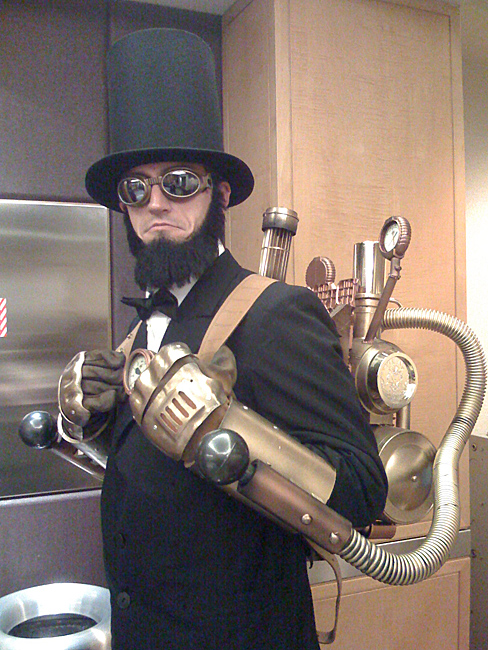Ok, so the danddwiki.com version of the
3.5 katana is a tad broken. But I like the spirit of the rules for it. It's a dynamic that allows multiple options to the wielder depending on their style of use (it can be finessed, wielded two handed, and the crit range and multiplier changes depending on training and use).
But it is perhaps the single most powerful mundane weapon if allowed to be used as written.
The problem with the standard 3.5 katana is that it's just a bastard sword. But would William Wallace and a samurai
really use the same weapon?
Without some change, the only reason a player would pick up the katana for their character would be for role playing flavor. I wanna find a middle ground.
To the exasperated reader who stomped feet about a two-handed finesse-able weapon being stupid and without precedent: FAIL. It's already been done in 3.5. Please read the
spiked chain entry.
How about this? Stats are for a medium katana.
Katana (Exotic One/Two-Hand Melee)
Cost: 150gp
Dmg 1h: d8
Dmg 2h: d10
Crit: 19-20/x2
Weight: 5lb
You can use your weapon finesse feat to apply your Dexterity modifier instead of your Strength modifier to attack rolls with a katana, but this may only be used while wielding the weapon one-handed.
Wielding the weapon with two hands increases the damage to d10 and adds 2 to damage when sundering.
Comparative notes on balance: When wielded one-handed, this weapon hangs in the balance between the longsword (d8 dmg, 19-20 crit, no finesse) and the elven thinblade (d8 dmg, 18-20 crit, finesse). Wielded with two hands, this weapon lies in between the greatclub (d10 dmg, 20 crit, no special feat required if 2h) and the bastard sword (d10 dmg, 19-20 crit, no special feat required if 2h).
So if this weapon lies in between existing weapons on the spectrum, why would you wield it? OPTIONS.
If your character is William Wallace, choose the bastard sword, or the greatsword. If your character is Elebros Moonblade, wispy loafer-light fighter, choose the thinblade. But if you have an above average dexterity, and want to have OPTIONS when fighting without changing weapons, wield the katana.
This katana is truly for the Asian-inspired martial artist character.
The more research I did on the katana the more I saw a similar thread. This blade was made for samurai to react suddenly to their foes. By sheathing it blade up, they could strike while drawing it. I couldn't find any 3.5 feats to this effect, so here's one I made.
NEW FEAT:
Draw Strike
Prerequisites: Base Attack +6, Exotic Weapon Proficiency: Katana, Weapon Focus: Katana, Quick Draw
This feat allows the wielder to draw their katana and strike in the same motion. When drawing the katana, the wielder may make a single melee attack at his highest base attack bonus as a free action in conjunction with drawing the weapon. He may then 'complete' a full attack as a standard action, using any remaining attacks from his normal total number of attacks.
Example: Kao Kao, a tenth level fighter, walks into an ambush with his weapon sheathed. He notices his foes and gets to act during the surprise round. During the surprise round (assuming the ambushers were in melee range) he may draw his katana and strike in one motion using his highest base attack bonus (+10). As this is a free action, he may still take either a move action or standard action during this surprise round. He chooses to take a standard action to 'finish' his full attack, and attacks again using his next-highest base attack (+5). He could also take a single move after his draw strike.
Another Example: Kao Kao, now fifteenth level, is parlaying with a sinister feudal lord. Negotiations go sour, and the lord draws his blade and casts an abjuration on himself. Kao, seeing his opportunity, draws and strikes as a free action using his highest base attack bonus (+15). He now has options: finish his attack (two more attacks, using his progressively lower base attack bonuses (+10/+5) as a standard action then and a single move; or give up the full attack and make a sprint move, or plenty of other options.
 returned home to the ranch in Longsaddle after a month away in the Spine of the World. A snake was lying across his path, sunning itself. It eyed him with contempt. He stabbed it. It became a serpent-looking humanoid (a Yuan-ti) and ran away. The next day he confronted an odd visitor at his ranch on that same road. The human tried to get away, but showed his true colors in trying to steal the bard's fabled drum. Battle ensued, and the man turned into a tiny viper, sliding away into the weeds. Later he assumed humanoid form again, this time showing his reptilian heritage. It died at the hands of Trill and his friends. It left behind several noteworthy items, one of which this magical sword (yay!):
returned home to the ranch in Longsaddle after a month away in the Spine of the World. A snake was lying across his path, sunning itself. It eyed him with contempt. He stabbed it. It became a serpent-looking humanoid (a Yuan-ti) and ran away. The next day he confronted an odd visitor at his ranch on that same road. The human tried to get away, but showed his true colors in trying to steal the bard's fabled drum. Battle ensued, and the man turned into a tiny viper, sliding away into the weeds. Later he assumed humanoid form again, this time showing his reptilian heritage. It died at the hands of Trill and his friends. It left behind several noteworthy items, one of which this magical sword (yay!):

